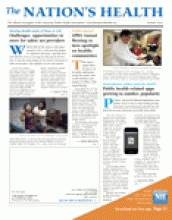Violence against health workers and facilities causes millions of people around the globe to go without needed care, a recent international report finds.
Wounded and sick people are sometimes denied effective health care because hospitals are damaged by weapons or fighters, ambulances are hijacked and health workers are threatened, kidnapped, injured or killed, according to the report. Such deliberate assaults on global health workers, facilities and emergency vehicles obstruct care, violate international laws protecting wounded people during armed conflicts and represent one of the world’s most serious humanitarian challenges, according to “Health Care in Danger.”
Released in July by the International Committee of the Red Cross, the report draws on health care data from 16 countries where the organization is operational. The data — describing 655 violent incidents — were collected between July 2008 and December 2010.
“Violence against health care facilities and personnel must end,” Yves Daccord, director-general of the International Committee of the Red Cross, said in a statement. “It’s a matter of life and death. The human cost is staggering. Civilians and fighters often die from their injuries simply because they are prevented from receiving timely medical assistance.”
According to the report, 33 percent of the violent incidents studied, or 216 of 655 events, were committed by members of a country’s police or military forces. About 37 percent of the violent events were committed by armed groups that are not part of a state or country’s police or military forces.
Violence that prevents the delivery of health care is one of the most urgent, yet overlooked, humanitarian tragedies, Daccord said.
“Hospitals in Sri Lanka and Somalia have been shelled, ambulances in Libya shot at, paramedics in Colombia killed and wounded people in Afghanistan forced to languish for hours in vehicles held up in checkpoint queues,” he said. “The issue has been staring us in the face for years. It must end.”
Countries that have suffered long periods of conflict have the lowest numbers of health workers, according to the report. For example, countries in the United Nations Security Council have, on average, 28 doctors and 56 nurses per 10,000 residents. In comparison, for every 10,000 people, Afghanistan has two doctors and five nurses, the Democratic Republic of the Congo has one doctor and five nurses and Iraq has five doctors and 10 nurses.
The health care community alone cannot address the challenge, according to the report, which calls on states, the armed forces and others who exercise authority to recognize that violence disrupts the delivery of health care.
“The most shocking finding is that people die in large numbers not because they are direct victims of a roadside bomb or a shooting,” said Robin Coupland, the study’s lead researcher. “They die because the ambulance does not get there in time, because health care personnel are prevented from doing their work, because hospitals are themselves targets of attacks or simply because the environment is too dangerous for effective health care to be delivered.”
Millions of lives could be spared if health care delivery were more widely respected, Coupland said.
Download the report at www.icrc.org/resources.
- Copyright The Nation’s Health, American Public Health Association









